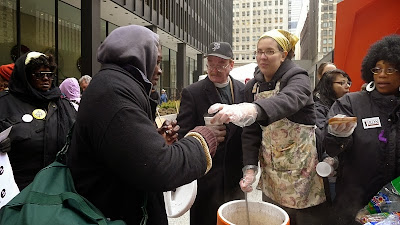Breadlines are making a comeback.
At the NYT's Editorial Page Editor's blog, Teresa Tritch:
The Great Recession was the worst downturn since the Great
Depression. And yet, throughout the recent decline and today’s sluggish
recovery, conditions have never seemed as bad as they were in the
1930s. Breadlines, for example, have not been commonplace.
That may be about to change.
In an article published on Monday, The Times’s Patrick McGeehan described
a line snaking down Fulton Street in Brooklyn last week, with people
waiting to enter a food pantry run by the Bed-Stuy Campaign Against
Hunger. The line was not an anomaly. Demand at all of New York City’s
food pantries and soup kitchens has spiked since federal food stamps
were cut on Nov. 1. The cut — which affects nearly all of the nation’s
48 million food stamp recipients — amounts to a loss of $29 a month for a
New York City family of three. On the shoestring meal budgets of food
stamp recipients, that’s enough for some 20 individual meals, according
to the New York City Coalition Against Hunger.
The food stamp cuts are occurring even though need is still high and
opportunity low. In a report released today, the Coalition estimates
that one-sixth of the city’s residents and one-fifth of its children
live in homes without enough to eat. Those numbers have not improved
over the past three years. The lack of economic recovery for low income
New Yorkers is at odds with gains at the top of the income ladder,
reflected in soaring real estate prices, rising stock prices and big
Wall Street bonuses.
And there are more food-stamp cuts to come. House Republicans have
proposed to cut the program by $40 billion over 10 years in the pending
farm bill; the Senate has proposed a $4 billion reduction. With Congress
framing its task not as whether to cut the program, but how much, is
there any doubt that food lines will soon be getting longer — and
children hungrier?
If the current downturn has not mirrored the Great Depression, that’s
thanks to safety net programs that grew out of the Depression and other
hard times. Breadlines have, by and large, been replaced by food
stamps, while income from Social Security, unemployment benefits and the
earned income tax credit has kept many people from falling
irretrievably into the economic abyss.
Without those supports, conditions — which are bad enough — would be
much worse, as is clear from the Census Bureau’s latest poverty
measures. According to the bureau:
- Poverty among children, at 18 percent in 2012, would have been
nearly 21 percent, but for food stamps; it would have been nearly 25
percent but for household income from tax credits like the one for
earned income.
- Poverty among the elderly, at 14.8 percent, would be nearly 55 percent, but for Social Security.
- Poverty among non-elderly adults, at 15.5 percent, would be 16.4 percent, but for unemployment benefits.
Now is not the time to cut back. Now is the time to provide.


No comments:
Post a Comment